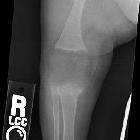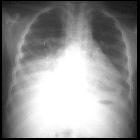Erlenmeyer flask deformity

















Erlenmeyer flask deformity (EFD), also known as metaphyseal flaring, refers to a radiographic appearance typically on a femoral radiograph demonstrating relatively reduced constriction of the diaphysis and flaring of the metaphysis as a result of undertubulation.
The name refers to the resemblance to a flat bottomed titration flask used by chemists, (known as a conical flask in British English.)
Pathology
It has been classically used with reference to the distal ends of the femora, however it is also seen in the proximal humeri, tibiae, and the distal radii and ulnae .
Etiology
- marrow infiltration/expansion
- lysosomal storage disease
- Gaucher disease - osteopenia with Legg-Calvé-Perthes disease or Hass disease
- Niemann-Pick disease (type B)
- hemoglobinopathies
- thalassemia - coarsened trabeculation, cobweb appearance, especially if treated with desferoxamine
- sickle cell disease
- membranous lipodystrophy
- fetal magnesium toxicity
- chronic lead toxicity (contentious )
- lysosomal storage disease
- bone dysplasias
- craniotubular bone dysplasias
- frontometaphyseal dysplasia
- craniometaphyseal dysplasia
- craniodiaphyseal dysplasia
- craniometadiaphyseal dysplasia
- diaphyseal dysplasia (Engelmann type)
- oculodentoosseous dysplasia
- metaphyseal dysplasia - Pyle disease
- sclerotic diaphysis
- dysosteosclerosis
- Melnick-Needles osteodysplasty
- Pyle-like dysplasias
- Braun-Tinschert myelodysplasia
- hypertrichotic osteochondrodysplasia (Cantu syndrome)
- multicentric fibromatosis with metaphyseal dysplasia
- osteopetrosis - diffuse sclerosis and sclerotic vertebral endplates (sandwich vertebrae)
- infantile osteopetrosis
- juvenile osteopetrosis (types II and III)
- osteopetrosis with renal tubular acidosis
- fibrous dysplasia
- achondroplasia
- Ollier disease
- multiple hereditary exostoses
- craniotubular bone dysplasias
The causes can also be remembered with the mnemonics AP OF DR GHLN, CHONG or Lead GNOME.
History and etymology
The conically-shaped flask with a wide base and short narrow neck was created by the German chemist Emil Erlenmeyer (1825–1909) in 1860 .
See also
Siehe auch:
- Fibröse Dysplasie
- Rheumatoide Arthritis
- Rachitis
- Down-Syndrom
- Achondroplasie
- Sichelzellenanämie
- Osteopetrose
- Ollier-Syndrom
- Thalassämie
- Morbus Gaucher
- Menkes-Syndrom
- Pyle-Syndrom
- Dysosteosklerose
- Erlenmeyerkolben
- Diamond-Blackfan syndrome
- CHONG
- Lead GNOME
und weiter:

 Assoziationen und Differentialdiagnosen zu Auftreibung Metaphysen:
Assoziationen und Differentialdiagnosen zu Auftreibung Metaphysen:









